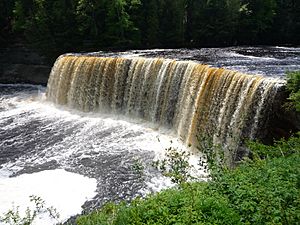Tahquamenon River facts for kids
Quick facts for kids Tahquamenon River |
|
|---|---|

The Upper Falls on the Tahquamenon River.
|
|
| Physical characteristics | |
| Main source | Columbus Township, Luce County, Michigan 46°28′59″N 85°50′43″W / 46.48304°N 85.84514°W |
| River mouth | Lake Superior, Michigan 46°33′18″N 85°01′46″W / 46.55502°N 85.02953°W |
| Length | 89 mi (143 km) |
| Basin features | |
| Basin size | 820 sq mi (2,100 km2) |
| Official name: Tahquamenon (East Branch) | |
| Type: | Wild, Recreational |
| Designated: | March 3, 1992 |
The Tahquamenon River is a long river in the U.S. state of Michigan. It flows for about 89 miles (143 km) through the eastern part of the Upper Peninsula. This river is special because it is a blackwater river, meaning its water is dark, like tea. This color comes from plants in the wetlands where the river begins.
The Tahquamenon River starts in Luce County and flows into Lake Superior near the village of Paradise. It drains a large area of the Upper Peninsula, including parts of Luce and Chippewa counties. You can even find M-123 running alongside some parts of the river.
Contents
What Does the Name "Tahquamenon" Mean?
The exact meaning of the name "Tahquamenon" is a bit of a mystery. Over the years, many ideas have been suggested for what the name means.
Some people called it the "River of the Head Winds." This was because they often had to paddle against the wind on the lower part of the river. Others simply called it the "River of a Hundred Bends" because of its many curves.
Descendants of the local Ojibwe people in the 1900s had their own ideas. They translated the name to mean things like "river up against a hill" or "lost river island." Some even thought it meant "river with an island part way."
In 1930, a scholar named Father William Gagnieut looked into the name. He concluded that the original meaning of "Tahquamenon" had been lost over time.
Old Names and Possible Meanings
The river's name has been spelled many different ways throughout history. Some old spellings include 'Otikwaminang' and 'Tanquamanon'. The spelling we use today, 'Tahquamenon', might come from a 1672 map of Lake Superior. This map named a small island near the river's mouth "Outa koua minan."
Here are some other ideas people had about the name's meaning:
- "Shortcut": This idea suggests the name first referred to Tahquamenon Bay. The Ojibwe people might have used this bay as a shortcut when traveling. The bay has a small island that made it easier to cross the open and sometimes dangerous bay from Whitefish Point. Later, the river flowing into the bay got the same "shortcut" name.
- "Marsh of the blueberries": While 'menon' does mean "blueberries" in the Ojibwe language, the first part of the name, 'tahqua', doesn't mean "marsh."
- "Ottawa's good land": This idea comes from an Ottawa village that used to be near the river's mouth.
- "Dark-colored water": Even though the river's water is dark, the Ojibwe word for "dark-colored water" is different from Tahquamenon.
Today, the Ojibwe name for the Tahquamenon River is Adikamegong-ziibi. This means "River where the Whitefish are found." This name is also why places like Whitefish Point and Whitefish Bay are called that.
Tahquamenon Falls: Michigan's Famous Waterfalls
The Tahquamenon River is most famous for the Tahquamenon Falls. These are two amazing waterfalls located in Tahquamenon Falls State Park. Together, the falls drop about 73 feet (22 meters).
The river's water has a unique brown or golden-brown color. This is because the river starts in a wet, swampy area with many cedar, spruce, and hemlock trees. These trees release a natural dye called tannin into the water. This makes the Tahquamenon Falls the largest naturally colored waterfall in the United States!
The state park protects the waterfall area and about 24 miles (39 km) of the river. It's a beautiful place to visit.
Fun Activities on the Tahquamenon River
The Tahquamenon River is a great place for outdoor fun. In Henry Wadsworth Longfellow's famous poem, The Song of Hiawatha, the hero learned how to paddle a birchbark canoe on the Tahquamenon. People still enjoy canoeing on the river today!
The river's area and the state park are also popular for fishing and hiking. When winter arrives, the area becomes a favorite spot for snowmobilers.
Take a Tour Boat on the River
If you want to see the river in a special way, you can take a tour! The Toonerville Trolley Train and Riverboat Tour is a private company that offers boat trips. These tours cover about 21 miles (34 km) of the upper Tahquamenon River.
The tour is part of a fun family experience. It includes a ride on a narrow-gauge train and a visit to the Upper Tahquamenon Falls. The tour starts in Soo Junction, which is between Newberry and Hulbert.

